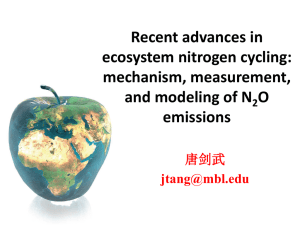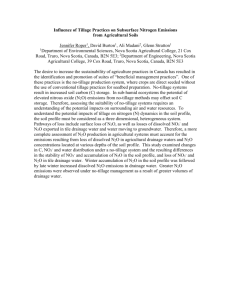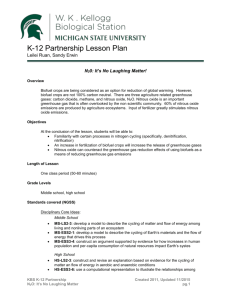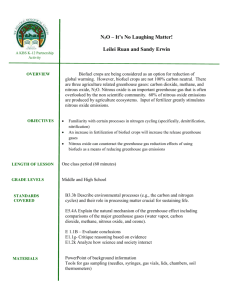Workplan
advertisement
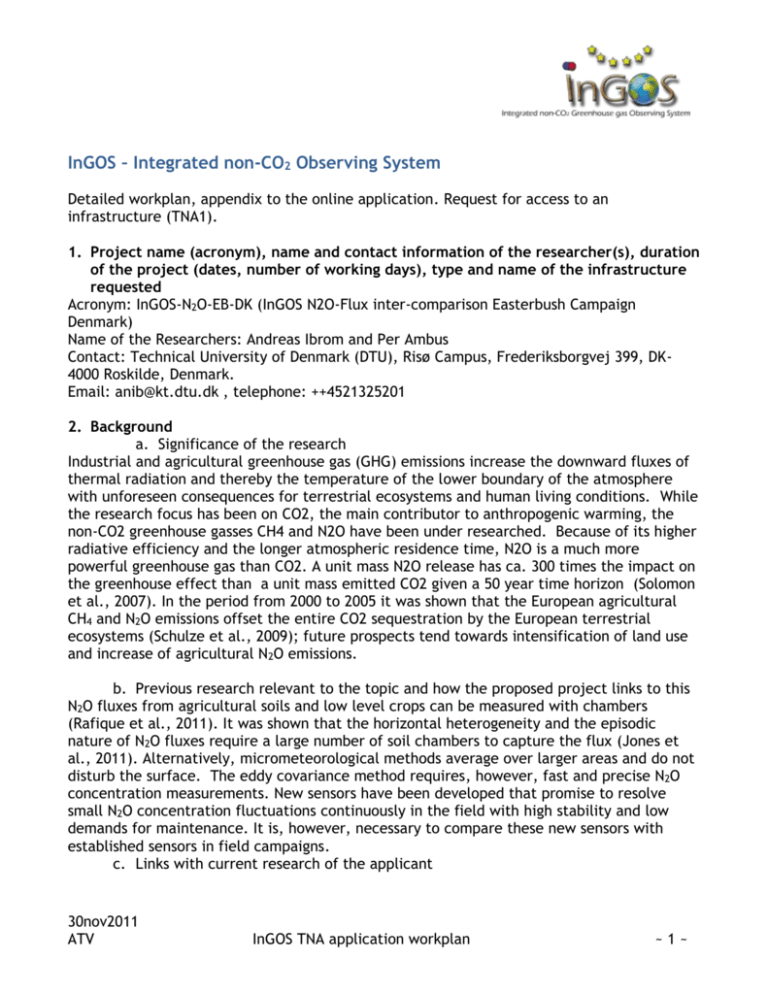
InGOS – Integrated non-CO2 Observing System Detailed workplan, appendix to the online application. Request for access to an infrastructure (TNA1). 1. Project name (acronym), name and contact information of the researcher(s), duration of the project (dates, number of working days), type and name of the infrastructure requested Acronym: InGOS-N2O-EB-DK (InGOS N2O-Flux inter-comparison Easterbush Campaign Denmark) Name of the Researchers: Andreas Ibrom and Per Ambus Contact: Technical University of Denmark (DTU), Risø Campus, Frederiksborgvej 399, DK4000 Roskilde, Denmark. Email: anib@kt.dtu.dk , telephone: ++4521325201 2. Background a. Significance of the research Industrial and agricultural greenhouse gas (GHG) emissions increase the downward fluxes of thermal radiation and thereby the temperature of the lower boundary of the atmosphere with unforeseen consequences for terrestrial ecosystems and human living conditions. While the research focus has been on CO2, the main contributor to anthropogenic warming, the non-CO2 greenhouse gasses CH4 and N2O have been under researched. Because of its higher radiative efficiency and the longer atmospheric residence time, N2O is a much more powerful greenhouse gas than CO2. A unit mass N2O release has ca. 300 times the impact on the greenhouse effect than a unit mass emitted CO2 given a 50 year time horizon (Solomon et al., 2007). In the period from 2000 to 2005 it was shown that the European agricultural CH4 and N2O emissions offset the entire CO2 sequestration by the European terrestrial ecosystems (Schulze et al., 2009); future prospects tend towards intensification of land use and increase of agricultural N2O emissions. b. Previous research relevant to the topic and how the proposed project links to this N2O fluxes from agricultural soils and low level crops can be measured with chambers (Rafique et al., 2011). It was shown that the horizontal heterogeneity and the episodic nature of N2O fluxes require a large number of soil chambers to capture the flux (Jones et al., 2011). Alternatively, micrometeorological methods average over larger areas and do not disturb the surface. The eddy covariance method requires, however, fast and precise N2O concentration measurements. New sensors have been developed that promise to resolve small N2O concentration fluctuations continuously in the field with high stability and low demands for maintenance. It is, however, necessary to compare these new sensors with established sensors in field campaigns. c. Links with current research of the applicant 30nov2011 ATV InGOS TNA application workplan ~1~ The applicants are participants of the InGOS EU project. There we apply a Los Gatos Research N20/CO/H2O Analyzer using the Off-axis, Integrated Cavity Output Spectroscopy technology, a development from the cavity enhanced absorption technique, to measure N 2O fluxes between a willow plantation and the atmosphere. The Willow site is characterized by very low N2O fluxes which are comparable to forest sites (Eugster et al., 2007; Pihlatie et al., 2005) and comparison of the equipment at a high emission site with other similar equipment is necessary to characterize the spectral behavior decently above the detection limit of the measurement. 3. Objectives a. Hypothesis and research objectives H1: The LGR – off axis ICOS laser is able to resolve turbulent concentration fluctuations with sufficient chemical precision and known, acceptable frequency cut-off. H2: Using different types of N2O eddy covariance equipment (N2O concentration analysis and sonic anemometry) in parallel yields flux results within uncertainty ranges at a site with stationary N2O flux conditions. H3: If H2 has been proven, eddy covariance systems at different heights or different locations can demonstrate the effects of horizontal heterogeneity of N2O fluxes at a given site. b. Connection with the InGOS objectives and the ‘fitness’ of the use of the requested infrastructure to the objectives The InGOS research infrastructure relies on comparable flux measurement methodology. It is necessary to show that different equipment yields comparable flux estimates, when run under the same conditions and processed with a standardized protocol. 4. Methods and materials (legal and ethical issues) a. Research method, explaining how to reach the objective Instruments from our group will be set up together with similar equipment in a standardized way to compare the measurements of N2O fluctuations and the 3D wind speed components. The equipment will be installed on the border between two intensively-managed grassland fields in the Easterbush field site that is maintained by the CEH, Edinburgh. To generate different flux levels this will happen before and after a fertilization event. b. Research materials, instrumentation We will install a LGR N2O/CO/H2O laser for N2O concentration measurement together with a GILL HS 50 research 3D sonic anemometer and a logging system based on a Campbell Scientific CR-3000 data logger. c. Governance procedures, safety precautions, permit requirements and procedures The equipment will be installed during the week before the campaign and then run and maintained by CEH staff. Data quality will be controlled via remote access from Denmark. 5. Implementaton: timetable, budget, distribution of work a. Timetable for the research including personnel efforts, favorably table wise Action From To Personnel Cost efforts 30nov2011 ATV InGOS TNA application workplan ~2~ Transport of the equipment to the site Roskilde – Easterbush by car Installation Calibration and tests Return to Roskilde 27.05.2013 29.05.2013 2 days travelling 250 € ferry (return) 150 € fuel 30.05. 01.06 3 user days at the site 01.05 02.06 2 days travelling 150 € fuel Equipment stays measuring at the site Travel by car from Roskilde to Edinburgh De-installations Travel back 31.05. 28.06 26.06. 27.06. Travelling 2 days 250 € ferry (return) 150 € fuel 28.06 01.07. 29.06. 02.07. 2 user days Travelling 2 days 150 € fuel b. Total budget for travel and logistical support as requested 5 RWD + 500 € travel and subsistence c. Plan for specific logistal needs like visa, import/export licenses etc. 6. Expected results and possible risks a. Expected scientific impact of the research Consolidation of the ability of the InGOS research infrastructure to measure N 2O fluxes within known uncertainty ranges at different sites. b. Applicability and feasibility of the research results Results from different N2O flux measurements will be compared and strengths and limitations of the individual set-ups evaluated. Flux measurements at high emission rates will enable proper and accurate characterization of the equipment used at the Danish InGOS infrastructure installations. c. Publication plan To be harmonized with the other groups that take part in the campaign. d. Data access plan Raw data will be accessible to the participants of the campaign near real time and after consolidation according to the data policy of InGOS. 7. Key literature a. List of references used in the working plan Eugster, W., Zeyer, K., Zeeman, M., Michna, P., Zingg, A., Buchmann, N. and Emmenegger, L., 2007. Methodical study of nitrous oxide eddy covariance measurements using 30nov2011 ATV InGOS TNA application workplan ~3~ quantum cascade laser spectrometery over a Swiss forest. Biogeosciences, 4(5): 927939. Fratini, G., Ibrom, A., Arriga, N., Burba, G. and Papale, D., 2012. Relative humidity effects on water vapour fluxes measured with closed-path eddy-covariance systems with short sampling lines. Agricultural and Forest Meteorology, 165(0): 53-63. Jones, S.K., Famulari, D., Di Marco, C.F., Nemitz, E., Skiba, U.M., Rees, R.M. and Sutton, M.A., 2011. Nitrous oxide emissions from managed grassland: a comparison of eddy covariance and static chamber measurements. Atmos. Meas. Tech., 4(10): 2179-2194. Ibrom, A., Dellwik, E., Jensen, N.O., Flyvbjerg, H. and Pilegaard, K., 2007. Strong low-pass filtering effects on water vapour flux measurements with closed-path eddy correlation systems. Agricultural and Forest Meteorology, 147: 140 -156. Ibrom, A., Dellwik, E., Larsen, S.E. and Pilegaard, K., 2007. On the use of the Webb Pearman - Leuning - theory for closed-path eddy correlation measurements. Tellus B, 59B: 937-946. Pihlatie, M., Rinne, J., Ambus, P., Pilegaard, K., Dorsey, J., Rannik, Ü., Markkanen, T., Launiainen, S. and Vesala, T., 2005. Nitrous oxide emissions from a beech forest floor measured by eddy covariance and soil enclosure techniques. Biogeosciences Discussions, 2(3): 581-607. Mammarella, I., Werle, P., Pihlatie, M., Eugster, W., Haapanala, S., Kiese, R., Markkanen, T., Rannik, U. and Vesala, T., 2010. A case study of eddy covariance flux of N2O measured within forest ecosystems: quality control and flux error analysis. Biogeosciences, 7(2): 427-440. Cited References: Eugster, W. et al., 2007. Methodical study of nitrous oxide eddy covariance measurements using quantum cascade laser spectrometery over a Swiss forest. Biogeosciences, 4(5): 927-939. Jones, S.K. et al., 2011. Nitrous oxide emissions from managed grassland: a comparison of eddy covariance and static chamber measurements. Atmos. Meas. Tech., 4(10): 21792194. Pihlatie, M. et al., 2005. Nitrous oxide emissions from a beech forest floor measured by eddy covariance and soil enclosure techniques. Biogeosciences Discussions, 2(3): 581-607. Rafique, R., Hennessy, D. and Kiely, G., 2011. Nitrous oxide emission from grazed grassland under different management systems. Ecosystems, 14(4): 563-582. Schulze, E., Luyssaert, S., Ciais, P., Freibauer, A. and Janssens, I., 2009. Importance of methane and nitrous oxide for Europe's terrestrial greenhouse-gas balance. Nature Geoscience, 2(12): 842-850. Solomon, S. et al., 2007. Climate Change 2007: The Physical Science Basis. Contribution of working Group I to the Fourth Assessment Report of the Intergovernmental Panel on 30nov2011 ATV InGOS TNA application workplan ~4~ Climate Change. Cambridge University Press, Cambridge, United Kingdom and New York, NY, USA., 987 pp. 30nov2011 ATV InGOS TNA application workplan ~5~

